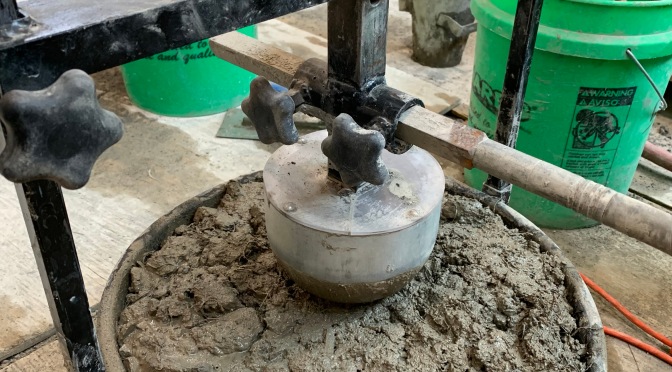Reinforcing concrete pavement with structural fibers improves its durability and helps protect against potential faulting and cracking. MnDOT has used fiber-reinforced concrete (FRC) on some concrete bridge decks and pavements. Winter weather, freeze-thaw cycles and road salt, however, still hasten concrete deterioration. In a recent study, researchers evaluated FRC in the context of performance engineered mix design methods, giving MnDOT confidence in the parameters that FRC needs to meet to help withstand Minnesota’s harsh weather.
MnDOT is a leader in using the performance engineered mixture (PEM) design method for pavements, which provides for a variety of testing to simulate actual conditions during pouring and throughout the concrete service life. Traditional concrete testing methods have been used for decades but are generally empirical, do not represent field conditions and are not specific to FRC. PEM design, on the other hand, uses new measurement technologies to identify the parameters a mixture should have to maximize strength and durability.
“This was our first study assessing fiber-containing concrete as a performance engineered mix, and we now understand the parameter ranges our fiber mixes need to have,” said Robert Golish, concrete engineer, MnDOT Office of Materials and Road Research.
To ensure fiber-containing concrete mixtures have the qualities that can help withstand Minnesota’s often harsh weather, MnDOT was interested in applying PEM design methods to verify the values for the FRC properties that would be specified to produce long-lasting pavements that reduce maintenance costs and improve road quality.
What Was Our Goal?
The goal of the study was to identify PEM target specifications for FRC mixtures to provide for durable and long-lasting pavement.
What Did We Do?
To begin, researchers performed a literature review on the PEM design procedure and key engineering parameters, fiber types and FRC properties. In the lab, they designed and tested 57 concrete mixes with PEM design methods. The mixes varied by fiber and aggregate type, workability and air voids.

With MnDOT’s input, researchers chose two synthetic fibers commonly used in pavement and three classes of coarse aggregates based on MnDOT’s standard construction specifications. Three target plastic air contents (4%, 6% and 8%) were tested, and the mixes were kept within acceptable workability ranges.
Researchers conducted concrete tests on each mix to understand the effect of the structural fibers. Significant tests in the PEM design method for fresh concrete included:
- Super Air Meter (SAM) test: Measures air content with a modified pressure meter at different pressures and assesses concrete’s resistance to freeze-thaw related distresses. Plain concrete should generally achieve a SAM number of 0.2, which corresponds to a durability factor of 70%.
- Box test: Assesses concrete’s response to vibration and its ability to hold its shape without crumbling during paving operations. The recommended representative number ranking for plain concrete, based on a visual inspection, is 1 to 2, which corresponds to 10% to 30% of surface voids (small cavities on the concrete’s surface).
- Vibrating Kelly ball (V-Kelly) test: Measures flowability under vibration to simulate field conditions as the rate of penetration of a Kelly ball attached to a vibrator in a trough of concrete. A V-Kelly index between 0.8 and 1.2 is appropriate for plain concrete.
Other tests measured hardened concrete properties, including compressive strength, flexural toughness and stiffness, and the resistivity to water penetration and freeze-thaw cycles.
“MnDOT engineers can have confidence in using fiber-reinforced concrete in the PEM platform as they now have target ranges for a more durable concrete,” said Manik Barman, associate professor, University of Minnesota Duluth Department of Civil Engineering.
Using the test results, researchers developed draft specifications for the recommended parameter ranges for FRC mixtures.
What Did We Learn?
Applying the PEM design procedure to FRC, researchers demonstrated the appropriate ranges of fresh concrete properties:
- SAM number—FRC achieves a comparable SAM number as plain concrete (0.2), though it may need more water-reducing admixture to be as workable and have the same air content. Researchers recommend the SAM number for FRC mixes could be as high as 0.3.
- Box test rating—Adding fibers to concrete resulted in higher ratings. Researchers recommend, again, adding a water-reducer additive to keep the surface air voids below 30%.
- V-Kelly index—Increased fiber dosages create a stiffer mixture with decreased workability (a lower index). To meet the desired range, steps should be taken to improve workability. However, a lower V-Kelly index may be appropriate for FRC as strength and durability criteria were met. But further investigation of workability is needed before making this recommendation.
The tests for hardened concrete showed fiber had little effect on the compressive strength of concrete, while flexural toughness, or crack resistance, and residual strength improved significantly.
What’s Next?
This work supports MnDOT in incorporating specifications for fresh concrete properties of fiber-containing concrete into MnDOT’s Standard Specification for Construction and provides confidence that FRC mixes developed in accordance with the PEM design procedure will be durable and long-lasting for use in pavements and bridge decks.
Additional investigation into field mixes and testing, particularly to find an appropriate range for the V-Kelly index for FRC, may be warranted.


ULTRA HIGH PERFORMANCE CONCRETE w/fibers is currently being used in New York State and has been approved by the FhWA. DD